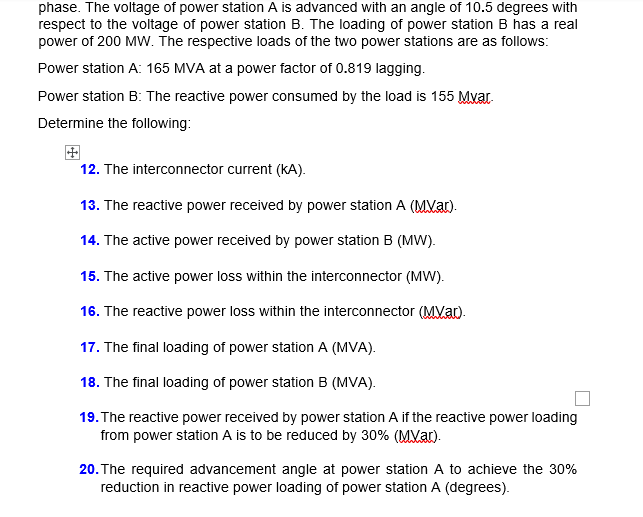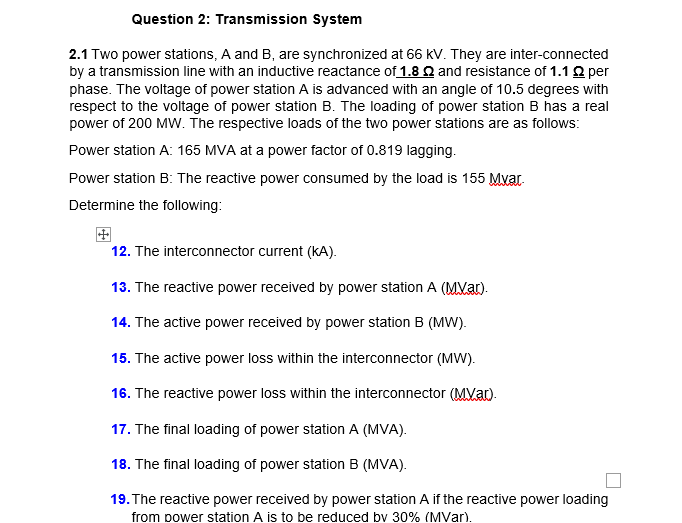phase. The voltage of power station A is advanced with an angle of 10.5 degrees with respect to the voltage of power station B. The loading of power station B has a real power of 200 MW. The respective loads of the two power stations are as follows: Power station A: 165 MVA at a power factor of 0.819 lagging. Power station B: The reactive power consumed by the load is 155 Mvar. Determine the following: 12. The interconnector current (kA). 13. The reactive power received by power station A (MVar). 14. The active power received by power station B (MW). 15. The active power loss within the interconnector (MW). 16. The reactive power loss within the interconnector (MVan. 17. The final loading of power station A (MVA). 18. The final loading of power station B (MVA). 19. The reactive power received by power station A if the reactive power loading from power station A is to be reduced by 30% (MVar). 20. The required advancement angle at power station A to achieve the 30% reduction in reactive power loading of power station A (degrees).
phase. The voltage of power station A is advanced with an angle of 10.5 degrees with respect to the voltage of power station B. The loading of power station B has a real power of 200 MW. The respective loads of the two power stations are as follows: Power station A: 165 MVA at a power factor of 0.819 lagging. Power station B: The reactive power consumed by the load is 155 Mvar. Determine the following: 12. The interconnector current (kA). 13. The reactive power received by power station A (MVar). 14. The active power received by power station B (MW). 15. The active power loss within the interconnector (MW). 16. The reactive power loss within the interconnector (MVan. 17. The final loading of power station A (MVA). 18. The final loading of power station B (MVA). 19. The reactive power received by power station A if the reactive power loading from power station A is to be reduced by 30% (MVar). 20. The required advancement angle at power station A to achieve the 30% reduction in reactive power loading of power station A (degrees).
Related questions
Question
The module is Energy systems 3

Transcribed Image Text:phase. The voltage of power station A is advanced with an angle of 10.5 degrees with
respect to the voltage of power station B. The loading of power station B has a real
power of 200 MW. The respective loads of the two power stations are as follows:
Power station A: 165 MVA at a power factor of 0.819 lagging.
Power station B: The reactive power consumed by the load is 155 Mvar.
Determine the following:
12. The interconnector current (kA).
13. The reactive power received by power station A (MXar).
14. The active power received by power station B (MW).
15. The active power loss within the interconnector (MW).
16. The reactive power loss within the interconnector (MVar).
17. The final loading of power station A (MVA).
18. The final loading of power station B (MVA).
19. The reactive power received by power station A if the reactive power loading
from power station A is to be reduced by 30% (MVar).
20. The required advancement angle at power station A to achieve the 30%
reduction in reactive power loading of power station A (degrees).

Transcribed Image Text:Question 2: Transmission System
2.1 Two power stations, A and B, are synchronized at 66 KV. They are inter-connected
by a transmission line with an inductive reactance of 1.8 Q and resistance of 1.12 per
phase. The voltage of power station A is advanced with an angle of 10.5 degrees with
respect to the voltage of power station B. The loading of power station B has a real
power of 200 MW. The respective loads of the two power stations are as follows:
Power station A: 165 MVA at a power factor of 0.819 lagging.
Power station B: The reactive power consumed by the load is 155 Mvar.
Determine the following:
12. The interconnector current (kA).
13. The reactive power received by power station A (MVar).
14. The active power received by power station B (MW).
15. The active power loss within the interconnector (MW).
16. The reactive power loss within the interconnector (MVa).
17. The final loading of power station A (MVA).
18. The final loading of power station B (MVA).
19. The reactive power received by power station A if the reactive power loading
from power station A is to be reduced bv 30% (MVar).
Expert Solution
This question has been solved!
Explore an expertly crafted, step-by-step solution for a thorough understanding of key concepts.
Step by step
Solved in 7 steps with 7 images

Knowledge Booster
Learn more about
Need a deep-dive on the concept behind this application? Look no further. Learn more about this topic, electrical-engineering and related others by exploring similar questions and additional content below.